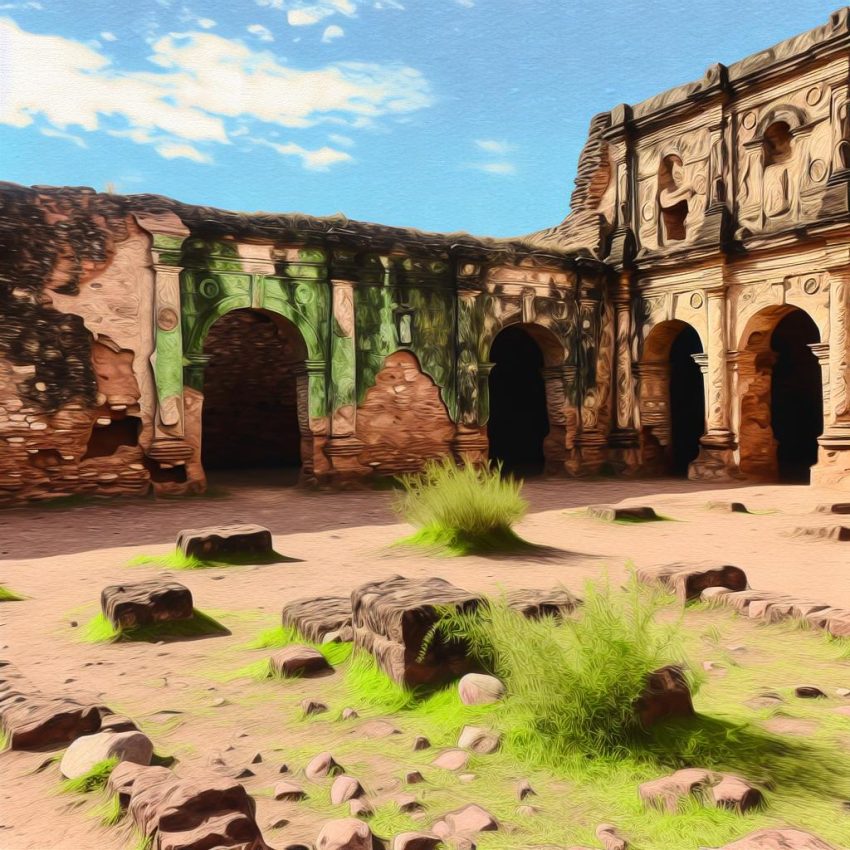Overview of San Ignacio Miní
The Ruins of San Ignacio Miní, located in Argentina’s Misiones Province, stand as one of the most significant remnants of the Jesuit missions in the region. Originally founded in 1632, this mission formed part of a broader network initiated by the Jesuits with the primary objectives of evangelizing the indigenous Guaraní people and integrating them into European societal frameworks. Today, San Ignacio Miní is recognized as a UNESCO World Heritage Site, celebrated for its profound historical and cultural significance.
Historical Context
The Jesuit missions of South America, spanning from the 16th to the 18th centuries, were characterized by their dual purpose. These missions aimed to spread Christianity while assimilating the local Guaraní population into systems aligned with European societal norms. As part of this endeavor, the missions expanded into communities that were largely self-sufficient, grounded in agriculture, education, and various crafts. San Ignacio Miní emerged as a major mission within this network, known for its impressive architecture and lively community, which thrived under the guidance of the Jesuits.
Architectural Features
The architecture of San Ignacio Miní illustrates a unique convergence of European and indigenous influences. Constructed primarily using red sandstone—an abundant material in the region—the mission’s structures are distinguished by their striking appearance. The baroque-style church façade is particularly notable, adorned with intricate carvings that bear witness to the skill and artistry of indigenous craftsmen who received training from the Jesuits.
Key Structures
Within the ruins of San Ignacio Miní, several key structures capture the essence of life in the mission. One of the most prominent structures is the large church, which, despite being partially destroyed, still exhibits elaborate stone carvings and friezes. These artistic elements offer a synthesis of religious symbolism and local artistic traditions, reflecting the cultural exchange that occurred. In addition to the church, the central plaza, residential quarters, and workshops provide further insights into the community’s organization. The residential areas, for instance, reveal how communal living was prioritized, with shared responsibilities playing a crucial role in daily life.
Preservation and Tourism
Over the years, considerable efforts have been dedicated to preserving San Ignacio Miní, ensuring that the site remains accessible as an important tourist destination. Guided tours are available for visitors, offering valuable insights into the mission’s history and its significance. These tours lead visitors through the ruins, deepening their understanding of the cultural exchange that took place between the Europeans and the Guaraní people.
For those interested in learning more, additional resources are available through platforms like the UNESCO World Heritage Centre. San Ignacio Miní continues to serve as a vital resource for both historians and tourists, providing a window into the complex history of the Jesuit missions across South America.
As one explores the ruins, many aspects stand out, contributing to a nuanced appreciation of the site’s importance in the historical narrative of Jesuit missions. The endeavor to create missions like San Ignacio Miní was not merely a religious exercise but also an exercise in cultural exchange and adaptation. In the missions, indigenous peoples were introduced to various European agricultural practices, educational systems, and craft techniques. This exchange was not unidirectional; it involved the blending of European and Guaraní worldviews, leading to a distinctive cultural synthesis.
The architectural splendor of San Ignacio Miní is among the most compelling elements of the mission. The use of locally sourced red sandstone reflects an adaptability to the natural environment, while the mission’s design highlights the Jesuits’ intent to create spaces that were not just functional but also inspiring and beautiful. The intricate carvings seen on the church’s façade and other surviving structures provide compelling evidence of the artistic sophistication that blossomed under the Jesuits’ tutelage.
Through these carved façades and crumbling stone walls, the ingenuity of the indigenous craftsmen who built them becomes ever more apparent. Far from being passive recipients of European culture, the Guaraní actively engaged with and contributed to the missions’ artistic achievements. This interplay of cultural influences is captured vividly in the surviving artworks and architecture.
Communal living, as evidenced by the residential structures at San Ignacio Miní, illustrates a lifestyle that was different from the isolated farmsteads or small townships seen in many parts of colonial Latin America. The Jesuits sought to organize life in a way that fostered community spirit and mutual support among residents. This approach not only aided in religious instruction but also ensured that the mission could sustain itself through collective agricultural efforts and shared workshops for various crafts.
Preservation efforts have sought to maintain these vestiges of a storied past, acknowledging the need to protect such heritage sites against natural decay and human-induced destruction. The importance of these ruins is recognized not just in terms of their regional or national significance but as part of the world’s broader cultural heritage. The ongoing conservation and tourism initiatives highlight a global acknowledgment of the need to safeguard such places for future generations.
When visiting San Ignacio Miní, tourists have the opportunity to immerse themselves in its profound historical narrative. Knowledgeable guides provide detailed tours, sharing stories of the site’s vibrant past and the intricate details of its architecture. Through these tours, visitors gain a more profound appreciation of the cultural exchanges that defined the region’s history.
In summary, San Ignacio Miní stands as a testament to a unique period in history marked by cultural convergence and adaptation. While the Jesuits introduced European elements, the resulting fusion with Guaraní culture produced a distinctive legacy that continues to resonate today. This legacy is not only visible in the physical remnants of the mission but also in the ongoing dialogue about cultural preservation and the interpretation of history. As one of the many Jesuit missions dotted across South America, San Ignacio Miní offers invaluable insights into the complexities of cultural encounters and the evolution of societal structures during a transformative era in history.

